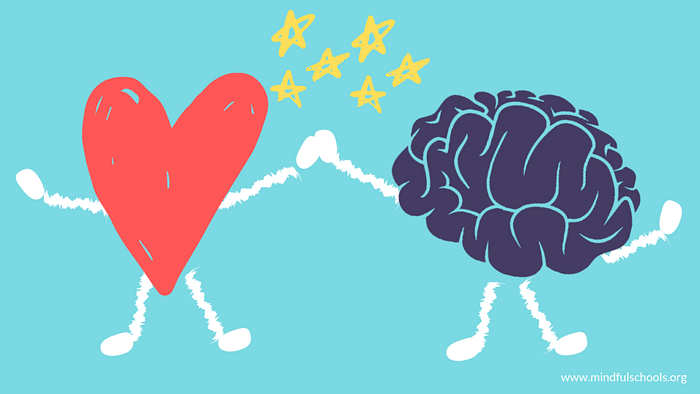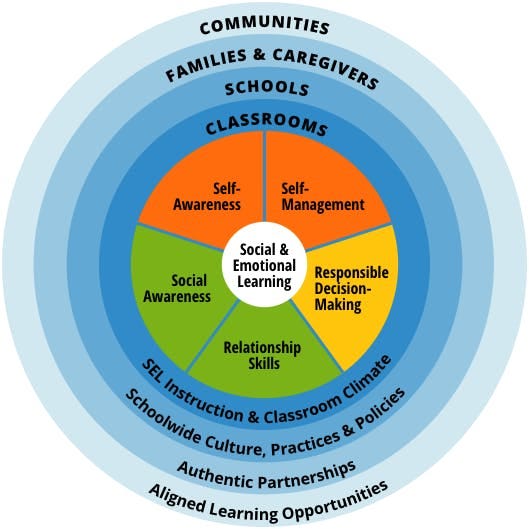Powerful Synergy: SEL and Mindfulness Working Together

- After asking her students to reflect on an essential question, a high school teacher in Oakland uses “wait time” to breathe mindfully, ground herself and set an intention to fully listen so she can offer her students her full presence.
- An elementary vice principal in Albany uses a snow globe to breathe deeply and calm emotions with a student in her office so they can center themselves before they engage in a restorative conversation.
- “I’m ready to learn now.” An elementary schooler in Dallas returns to his work station after spending time in a Peace Corner where he engaged in a few minutes of self-chosen activities including an audio guided mindfulness practice to help calm his mind and restore his confidence after feeling frustrated by a word problem.
- An ELL teacher in New York City begins every class having students coordinate their breathing with mindful movement to help students transition and ensure that while their bodies are in class, their minds are there too.
Each of the people in these real-life examples are engaging in Mindful Awareness Practices (MAPs) and putting learned SEL skills into action. In these examples, in fact, MAPs help create the positive conditions to strengthen student and educator social and emotional capabilities.
Mindful awareness practices (MAPs) are “exercises that promote a state of heightened and receptive attention to moment-by-moment experience” (Bishop et al., 2004; Siegel, 2007). Several practices or exercises are thought to increase this state of awareness, including forms of meditation, yoga, and Tai-Chi (Allen, Blashki, and Gullone, 2006; Wall, 2005). A common exercise involves directing the attention to a present experience or sensation, like the movement of the belly during in-and-out breaths. Quite often the attention will wander periodically from the focus area. Consciously recognizing this lapse in attention allows for the refocusing of awareness and drawing attention back to the original focus area. Without judgment, the practice is to simply return to intention of focusing attention. Practicing mindfulness is likened to practicing a sport or playing a musical instrument, in that proficiency is cultivated through repetition and continuous practice” (Flook et al., 2010).
SEL & MAPs: Complementary Elements

Both SEL and mindful practices are pathways to individual empowerment and collective advancement. Social and Emotional Learning (SEL) is a lifelong process by which youth and adults learn and integrate the intra- and interpersonal skills necessary for success in school and life. Mindfulness involves specific practices that help youth and adults in calming themselves, focusing their attention, and growing compassion thus creating the conditions for high-caliber academic learning and amplifying the effects of existing social-emotional programs and strategies.
A great way to understand the relationship between SEL and MAPs is a sports analogy first suggested by Dinabandhu Sarley of the 1440 Foundation, at a 2015 CASEL meeting that brought together experts and program providers in the fields of SEL and MAPs to explore the relationship between the two.
In sports, effective training usually involves two key elements:
- Learning and practice (SEL)
- Physical conditioning (MAPs)
“SEL uses an outside-in approach with a focus on building skills; Mindfulness works from the inside-out, building on everyone’s innate capacities for relationship building, such as empathy and kindness” (Lantieri & Zakrezewski, 2015). Mindful awareness practices promote mental fitness, which enhances learning. “The calmer, more focused mental state potentially achieved through MAPs may help students be less anxious and reactive so they can develop positive, healthy relationships with teachers and peers,” (Dusenbury, Sarley, Weissberg, & Domitrovich, 2016) which in turn, helps them be even more able to learn and demonstrate SEL skills.
Sharing Mindfulness with Young People
Mindfulness instruction can help students manage stress, regulate their emotions, and focus their attention so they can be available for academic, social, and emotional learning. Several evidence-based SEL programs have already begun incorporating mindfulness into their programming. While many of these programs lack a daily mindfulness practice component, the fact that well-established evidence-based SEL programs are incorporating mindfulness signals the growing importance of these practices to the SEL field.
Mindfulness for Teacher Wellness
MAPs are also increasingly part of teacher and leader wellness initiatives in schools and school districts, and there is growing research on how growing MAPs in teachers can positively influence their teaching practice and lead to increased teacher happiness and retention.
While there’s been tremendous growth in the number of educators who are trained in SEL and in mindfulness practices, and consequently a higher number of students who experience mindfulness engagements and SEL-based instruction, there are also significant concerns around either of these being used primarily as a behavior management tool. Mindful awareness practices can be a powerful complementary approach to enhance and reinforce comprehensive social and emotional learning, as long as mindful practices do not focus exclusively on self-regulation and instead lead to greater social awareness.
As an educator, how does this fit with my job?
With the passage of the Every Student Succeeds Act in 2015, states now have more flexibility in how they measure student achievement. The law removed references to “core academic subjects” and instead called for a “well-rounded education” for all students, thus raising the profile of SEL in education (Rosales, 2017).
This coincides with advances in research in the fields of neuroscience and educational pedagogy that demonstrate how social and emotional development is not only central to learning but is critical in order to thrive in all aspects of life — careers, relationships, and overall health and well-being. In fact, in a 2017 analysis of the SEL field conducted by Education First, creating coherence across SEL frameworks and terminologies was named as a top priority.
The National Commission on Social, Emotional, and Academic Development at the Aspen Institute is trying to fill this gap by bringing together policy makers, practitioners, and researchers from across the field. In May 2018 they offered the following comprehensive definition:
Social and emotional development comprises specific skills and competencies that people need in order to set goals, manage behavior, build relationships, and process and remember information. These skills and competencies develop in a complex system of contexts, interactions, and relationships, suggesting that organizations must take a comprehensive approach to promoting social and emotional development — addressing adult skills and beliefs; organizational culture, climate, and norms; and routines and structures that guide basic interactions and instruction — and that such approaches are most effective when designed to match the needs and contexts of specific organizations and communities.
Put simply, social and emotional development is not just about the skills that students and adults possess and deploy; it is also about the features of the educational setting itself, including culture and climate. (Aspen Institute, 2018)
This definition takes into account the importance of context when in engaging in SEL and positions SEL as more than just a set of skills and competencies developed irrespective of culture and community — or as something only for young people.
One of the most important aspects of this definition is the emphasis on addressing adult skills and beliefs. Central to the success of SEL is an examination of adult beliefs. SEL is not about fixing students but rather about seeing the whole picture of who we are, especially our strengths and assets. In light of this, complementing SEL with mindful awareness practices can be supportive in building greater self-awareness and social awareness for both students and adults.
And, there is a growing body of research to support bringing mindfulness into the classroom, although important research questions remain unanswered, including (1) the developmental appropriateness of strategies at different ages; (2) the intensity and duration necessary to improve student functioning; and (3) whether there is a lasting effect of at least one or two years following these interventions (CASEL, 2015).
Education as the Practice of Freedom: A Social Justice Proposal for Mindfulness Educators discusses how when “mindfulness is divorced from a social justice foundation it can be manipulated as a tool of the neoliberal market to improve test scores, increase attention, or control student behavior…Mindfulness education can help provide our students with a foundation of inner peace, calm and centered awareness, and offer a reprieve from self-defeating thoughts. If we integrate principles of compassion, interconnection, and solidarity along with concrete pathways to enact these principles in service to community empowerment and social justice, then we are birthing a new paradigm in mindfulness education” (Cannon, 2016) and one that aligns with transformative SEL.
Building Those Muscles — Get Started!
As with so many aspects of life, the first step can be the hardest — and continuing to take steps is the next challenge and joy!
- Start or build on your own personal engagement in grounding and mindful awareness practices.
- Start or build on your own professional engagement with Social and Emotional Learning.
- Infuse mindful awareness practices and SEL into your classroom and collegial work.
- Develop through print and virtual resources and by participating in professional learning.
This article was originally published for Mindful Schools.
Author Bio: Meena Srinivasan is a contemplative leader, celebrated speaker, accomplished author, and visionary edupreneur. She is an educator-activist at heart, consistently championing the fusion of Mindfulness, Emotional Intelligence, and Belonging. Meena was featured as one of 2022’s 10 Powerful Women of the Mindfulness Movement in Mindful Magazine and is the Executive Director of Transformative Educational Leadership (TEL)™ an organization that supports educational leaders in building more compassionate and just schools. A former public school administrator and National Board Certified Teacher, Meena is the creative force behind the SEL Every Day Online Courses, an instructor of graduate level Social and Emotional Learning (SEL) courses at UC Berkeley and the CEO of Karuna Consulting, LLC, an organization that takes its name from the Sanskrit word ‘Karuna,’ signifying compassion. Karuna Consulting is a certified Minority Business Enterprise (MBE) driven by a profound mission: to foster a more compassionate world through Meena’s keynotes, professional learning, coaching, and consulting services. She is the author of numerous publications including Teach, Breathe, Learn and SEL Every Day. The latter was honored as one of 2019’s Favorite Books for Educators by the Greater Good Science Center at UC Berkeley. Her TEDx talk on Tenderness is one of the most popular TEDx talks of 2024 (with over 2 million views). Meena has been practicing yoga and meditation for over 25 years, is an ordained Zen Buddhist and serves on the Board of the Thich Nhat Hanh Foundation. Learn more at meenasrinivasan.com.
